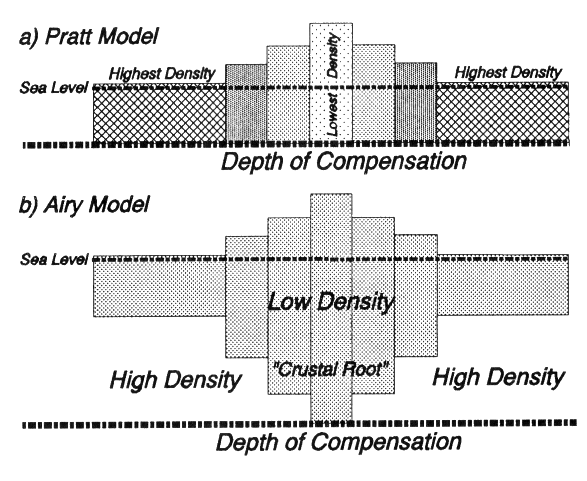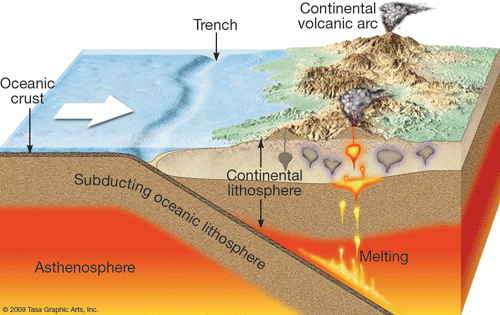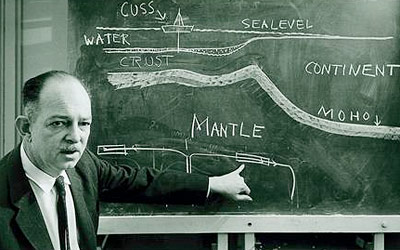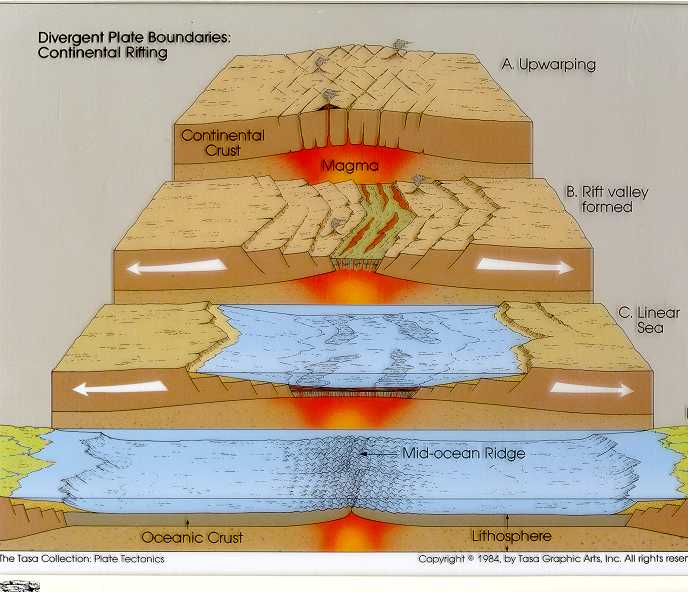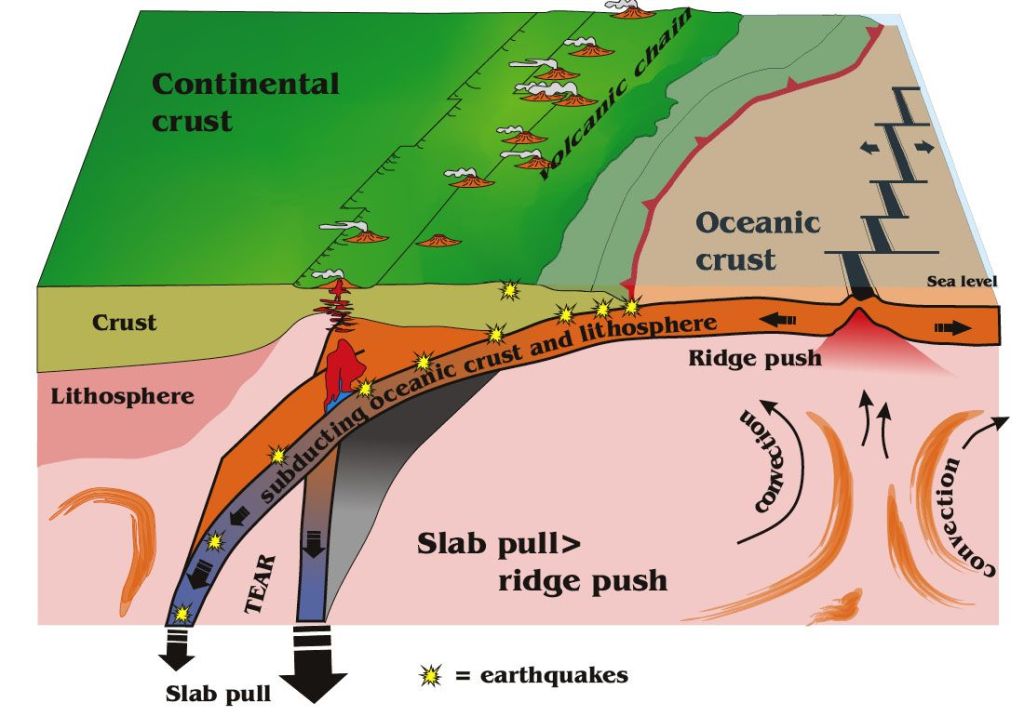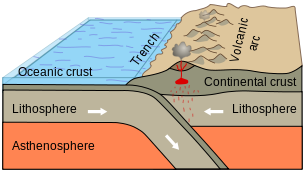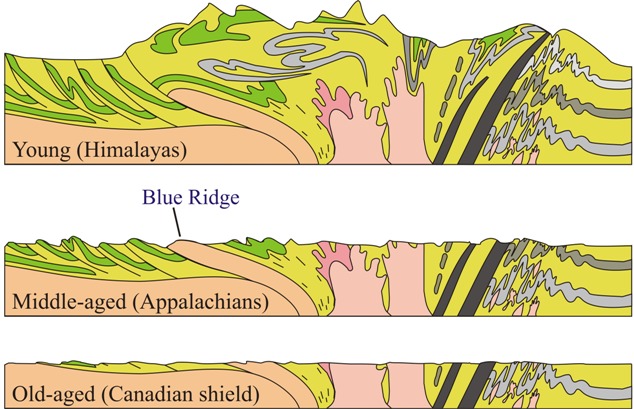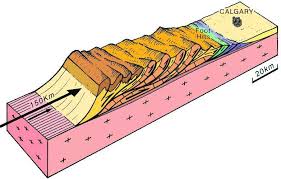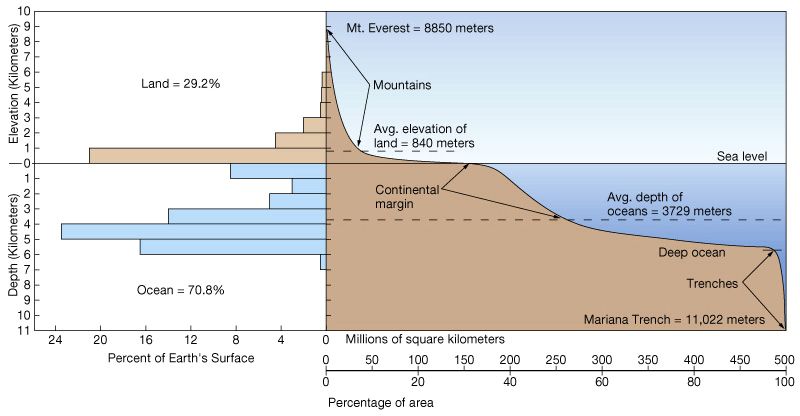 The surface of our planet varies greatly in altitude. In fact about ¾ are covered by seawater, whose average level has been conventionally chosen as a reference for the surface elevations. The statistical analysis of the elevations of the earth’s surface shows us something interesting: the highest percentage of the elevations is around two particular values that are the average level of the ocean floor (about -3790) and the average level of the emerged lands (about 840 m).
The surface of our planet varies greatly in altitude. In fact about ¾ are covered by seawater, whose average level has been conventionally chosen as a reference for the surface elevations. The statistical analysis of the elevations of the earth’s surface shows us something interesting: the highest percentage of the elevations is around two particular values that are the average level of the ocean floor (about -3790) and the average level of the emerged lands (about 840 m).
On the relative graph of the percentage distribution of the areas with respect to the altitudes, called “hypsographic curve”, it can be noted that the portions of surface that reach the minimum altitudes (about -11000 m of the Mariana Trench) and the maximum ones (8850 m of Mount Everest) are a very small fraction of the total.
In a nutshell, the mountain ranges are almost an exception, as are the oceanic trenches, on the surface of the Earth. They appear in so-called belts, which are considerably more developed in one direction than in the other. But what is it that keeps them standing at such exceptional altitudes compared to most of the land above ground?
The Theory of Isostasy
Between 1840 and 1850, the Welsh geographer George Everest (1790 – 1866) directed the first topographical survey of India. The methods used were traditional triangulation and the use of the position of a reference star at the same time of day. Both methods should have given identical results, but they did not; the error in measuring the distance of two cities, Kaliana and Kalianpur, respectively about 100 and 700 km away from the Himalayan range, was remarkable: the triangulation method gave 150 km more than the astronomical one
In 1854, the archdeacon of Calcutta John Henry Pratt (1809-1871), a science enthusiast, pointed out that the error was in astronomical measurements: to determine the position of a star you need to know exactly the direction of the zenith, i.e. the vertical line found with a plumb line. Pratt suggested that the gravitational attraction of the Himalayas and the Tibetan plateau on the plumb line was stronger in Kaliana, closer to the chain, than in Kalianpur and this would have caused the discrepancies that led to the error. However, when he calculated the magnitude of the error by evaluating the mass of the Himalayas and Tibet, he made a disconcerting discovery: the error was three times greater than that actually observed! The lead was deflected from the vertical at a lower angle than expected! (The attraction of the Himalaya Mountains upon the plumbline in India, Pratt 1855).
In other words, the calculation overestimated the masses of the Himalayas and Tibet; the mountains exerted a lower attraction than the one calculated on the basis of their density (actually Pratt had the topographic maps of the time that put the chain at not even half of what we now know, so he could have calculated an even higher missing mass).
Pratt suggested that under the mountains there was less dense material than the surrounding material, which would have kept the chain up by Archimedes’ push. In fact, according to Pratt, the parts of the crust with lower density were pushed higher: the greater the thickness of the crust, the lower the density, the greater the elevation reached; in this way the mountain chains, strong thickening of the crust, would have remained “afloat” like icebergs.
George B. Airy, eminent mathematical physicist and royal astronomer of England, read Pratt’s work in his London studio. It occurred to him that the surface of the Earth is probably not rigid enough to bear the load of the mountains without deforming. The deformation leads to a lack of mass under the mountains due to the less dense material that “fills” the curvature. So he contrasted the lateral variations in Pratt’s density with a crust lighter than the substrate on which it “floats”, of constant density but variable thickness.
In today’s state of knowledge, Pratt’s model is better adapted to the situation of the oceans while Airy’s model is more suitable for continental situations. To both of them goes the merit of having applied to the Earth the principle of isostasy: denser material tends to assume lower heights. This may explain the existence of the two preferential levels in the hypsographic curve as well as the strong elevation of the mountains.
Crust and Mantle
The average composition of the continental crust is close to that of granite, which has a density of about 2.6 – 2.7 g/cm3, while the oceanic crust shows a basaltic type composition, with a density closer to 3 g/cm3 and therefore it stabilizes at lower altitudes. All this whould lead to the assumption that the surface material “floats” on the one below, which has a higher density and fluid-like behavior, at least for very slow movements.
Seismology has provided key data in this regard. The seismic waves generated at the hypocentre of an earthquake are of two types: compression waves and shear waves. The former are faster and are the first impulse on seismograms; the latter, slower, have the important characteristic of being neither generated nor propagated in a fluid.
At the beginning of the century, the Croatian geophysicist Andija Mohorovicic (1857-1936) identified particular arrivals of seismic waves that could only be explained by a sharp increase in density at a depth of about fifty kilometers. The increase in density was explained by a change in composition at the transition between crust and mantle; the discontinuity was called “Mohorovicic’s surface”, in short “Moho”. Under the mountain ranges the Moho can reach a depth of 70 km.
But how were these crustal thickenings produced?
Continental Wondering
Analyzing the distribution of the mountain ranges and observing the coastlines to the east and west of the South Atlantic, German meteorologist Alfred Wegener (1880-1930) hypothesized that the two continents of Africa and South America had drifted apart and that resistance to drifting west of the Americas had generated the rocky mountains and the Andes. Insufficient, however, were the physical grounds on which he based his brilliant intuition: he proposed as the “engine” of the continents the resultant between the gravitational attraction towards the center of the Earth and the centrifugal force due to rotation, too weak to explain the movement of the continents. And how to justify the existence of imposing mountain ranges in the middle of the oceans?
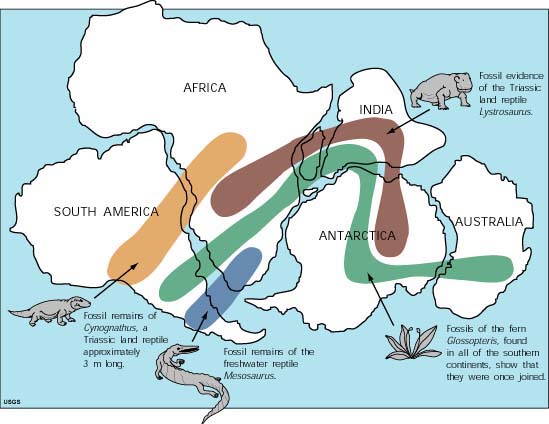 In contrast to the continental chains, the Moho below the oceanic ranges is shallow, until it disappears into the rift valleys in the middle of these ranges. Furthermore, seismology tells us that shear waves (the “S waves”) slow down abruptly, both under the oceans and under the mountain ranges, to a depth greater than that of the Moho (even 100 – 200 km, but down to zero in the oceanic rift zones). This can be explained by the existence of a partially melted zone (1% is sufficient) in the upper part of the mantle. It is called “asthenosphere”; the portion of the mantle above it, called “lid”, forms, together with the crust above it, the “lithosphere”.
In contrast to the continental chains, the Moho below the oceanic ranges is shallow, until it disappears into the rift valleys in the middle of these ranges. Furthermore, seismology tells us that shear waves (the “S waves”) slow down abruptly, both under the oceans and under the mountain ranges, to a depth greater than that of the Moho (even 100 – 200 km, but down to zero in the oceanic rift zones). This can be explained by the existence of a partially melted zone (1% is sufficient) in the upper part of the mantle. It is called “asthenosphere”; the portion of the mantle above it, called “lid”, forms, together with the crust above it, the “lithosphere”.
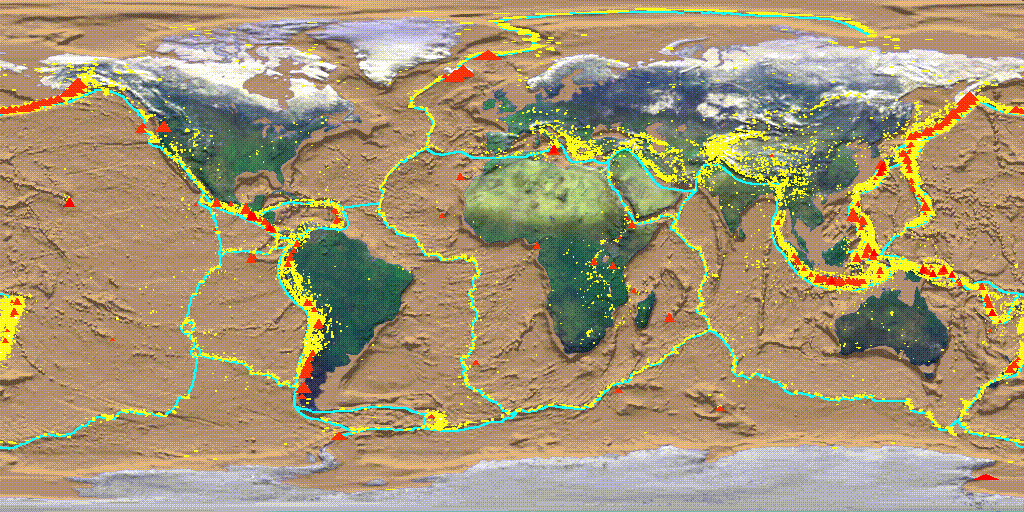 The distribution of earthquakes and volcanoes delimits portions of crust (or more precisely, of lithosphere) that are called “plates”. They can be formed by oceanic or continental lithosphere or both. Volcanism and seismicity are the expression of the interaction of the plates at their margins. Mountain ranges are also at the edge of the plates.
The distribution of earthquakes and volcanoes delimits portions of crust (or more precisely, of lithosphere) that are called “plates”. They can be formed by oceanic or continental lithosphere or both. Volcanism and seismicity are the expression of the interaction of the plates at their margins. Mountain ranges are also at the edge of the plates.
The eminent English geologist Arthur Holmes, considered one of the fathers of modern geology, provided a first plausible hypothesis on the movement of the lithospheric plates: convective motions in the asthenosphere would drag the overlying portions of the lithosphere. The lithosphere would be an integral part of the convective cell, simply the coldest and most external part of the cell, therefore not transported. According to Holmes, at the point where the hot material, as it expanded, rises, we would have emission to the surface of molten material (oceanic and continental rift volcanism) and creation of new lithosphere. In this way the ocean floor would expand in the rift zone, raised by the ascent of hot asthenospheric material; the continental rift would indicate the formation of a new ocean. Holmes’ hypothesis is remarkable, but it has the problem that the forces at play in the convective movement would be too low to move a plate. However, the expansion of the ocean floor would move the continents away (as Wegener supposed for South America and Africa).
But where does the newly formed material end up?
The Subduction Zones
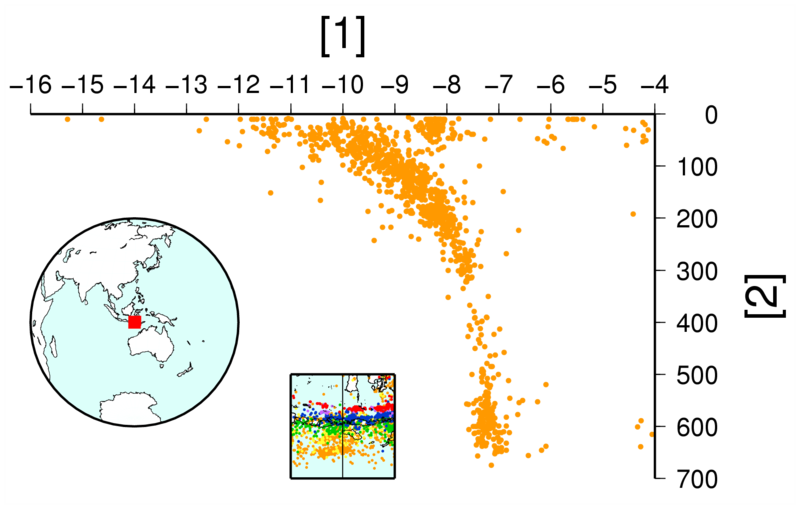 At this point the hypsographic curve comes back into play. The only portion left to explain is the one concerning the existence of a few elevation lows, those related to the oceanic trenches. Once again, seismology comes to our aid. In correspondence of the trenches earthquakes hypocenters are distributed around an imaginary plane dipping 40 to 70° in the mantle, up to a depth of about 700 km. This is the Benioff-Wadati area, the most plausible point on the planet where the consumption of the oceanic lithosphere in excess would take place (assuming the Earth is not swelling). The oceanic trenches would therefore be the surface expression of “subduction” oceanic lithosphere, which is plunging in the asthenosphere. The island arcs accompanying the trenches would thus be formed by volcanic material coming from the partial fusion of the subduction oceanic lithosphere as well as from the asthenospheric wedge above it. These zones are therefore converging plate margins (as opposed to the oceanic ridges and continental rift zones, which are divergent margins). Ocean trenches are the most plausible zones of descent of the cold portion of the convective cell.
At this point the hypsographic curve comes back into play. The only portion left to explain is the one concerning the existence of a few elevation lows, those related to the oceanic trenches. Once again, seismology comes to our aid. In correspondence of the trenches earthquakes hypocenters are distributed around an imaginary plane dipping 40 to 70° in the mantle, up to a depth of about 700 km. This is the Benioff-Wadati area, the most plausible point on the planet where the consumption of the oceanic lithosphere in excess would take place (assuming the Earth is not swelling). The oceanic trenches would therefore be the surface expression of “subduction” oceanic lithosphere, which is plunging in the asthenosphere. The island arcs accompanying the trenches would thus be formed by volcanic material coming from the partial fusion of the subduction oceanic lithosphere as well as from the asthenospheric wedge above it. These zones are therefore converging plate margins (as opposed to the oceanic ridges and continental rift zones, which are divergent margins). Ocean trenches are the most plausible zones of descent of the cold portion of the convective cell.
Ocean Floor Spreading
During World War II, Henry Hess, of Princeton University, was an officer in the U.S. Navy. On a mission in the Pacific, like a good geologist, thanks to sonar, he noticed the presence of numerous reliefs (seamounts) scattered in the ocean floor. He also noticed that many of them had a strangely flattened upper part, as if they had once been emerged, then sunk again. In honor of his professor he renamed them Guyot and suggested that they were dragged by the movement of the expanding oceanic plates from shallower areas, where they emerged and were eroded, to deeper areas where he had observed them. To Hess we owe the first concrete formulation of the theory of ocean floor spreading, inspired by an earlier idea of Robert Dietz of the Scripps Institute of Oceanography. Ocean floor spreading could explain why continents migrated: expanding oceans would push continents away.
But the evidence was missing.
In the early 1960s, the first data from oceanographic campaigns became available. In addition to numerous core drills, they had carried out extensive surveys of magnetic anomalies in the ocean floor. Lawrence Morley, of the Canadian Geological Survey, in conjunction with Frederick Vine of the University of Cambridge (left) and his PhD professor Drummond Matthews (1931-1997), were the first to explain the data, which gave much to think about:
the layer of fine sediment covering the abyssal seabed becomes thicker and thicker as you move away from the oceanic ridges; the radiometric age of the rocks beneath the sediments becomes older and older as you move away from the oceanic ridges; seismic surveys confirmed that the thickness of the oceanic crust and lithosphere increased as you move away from the ridges, as did their density and thickness; the heat flow decreases as you move away from the ridges.
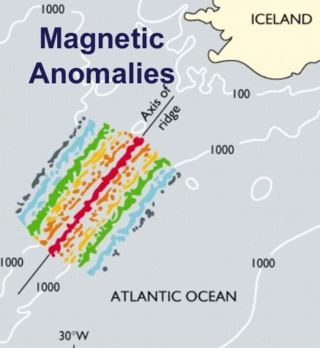 But the real surprise was the map of recorded magnetic anomalies. The rocks of the Earth’s crust, especially volcanic rocks, are naturally magnetized at the moment of their formation: iron-rich mineral particles are oriented according to the direction of the Earth’s magnetic field at the time (and place) of its formation. A magnetic anomaly is a deviation of the magnetization area from the average magnetization of a given area. The totality of the ocean depths surveyed showed some strange anomalies: they were organized in pairs of positive and negative anomalies (greater or lesser magnetization of the surrounding areas) which are regularly repeated starting from the oceanic ridges, which all showed positive magnetic anomalies.
But the real surprise was the map of recorded magnetic anomalies. The rocks of the Earth’s crust, especially volcanic rocks, are naturally magnetized at the moment of their formation: iron-rich mineral particles are oriented according to the direction of the Earth’s magnetic field at the time (and place) of its formation. A magnetic anomaly is a deviation of the magnetization area from the average magnetization of a given area. The totality of the ocean depths surveyed showed some strange anomalies: they were organized in pairs of positive and negative anomalies (greater or lesser magnetization of the surrounding areas) which are regularly repeated starting from the oceanic ridges, which all showed positive magnetic anomalies.
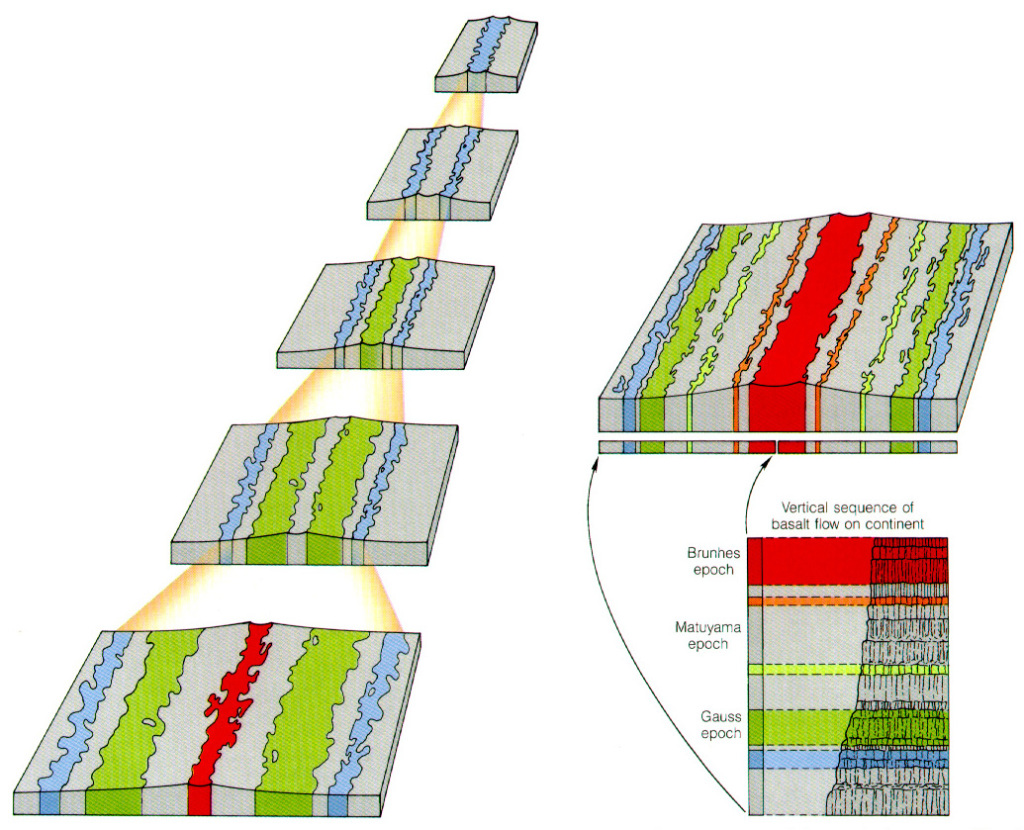 Morley, Vine and Matthews hypothesized that the positive anomalies along the ridges were due to the new rocks that formed from the magma coming out of the ridges, which solidified and became magnetized according to the existing direction of the Earth’s magnetic field of the time. The magnetization of the rocks adds to that of the current field resulting in a positive anomaly. As it was already well known from the analysis of the magnetization of lava flows of different ages superimposed, the Earth’s magnetic field had undergone several polarity reversals during the Quaternary. What if the bands of negative anomaly on the right and left of each ridge were due to rocks formed during a polar inversion? The magnetization acquired would have the opposite direction to the current one and would subtract from it, causing a negative anomaly. In short, the bands appeared positive would be rocks formed during periods without inversion of the poles, the negative ones would have formed instead during polar inversions. The ages of the rocks with negative anomaly corresponded perfectly with the dates of magnetic pole inversion in the geological record. The theory of ocean floor expansion finally had a proof.
Morley, Vine and Matthews hypothesized that the positive anomalies along the ridges were due to the new rocks that formed from the magma coming out of the ridges, which solidified and became magnetized according to the existing direction of the Earth’s magnetic field of the time. The magnetization of the rocks adds to that of the current field resulting in a positive anomaly. As it was already well known from the analysis of the magnetization of lava flows of different ages superimposed, the Earth’s magnetic field had undergone several polarity reversals during the Quaternary. What if the bands of negative anomaly on the right and left of each ridge were due to rocks formed during a polar inversion? The magnetization acquired would have the opposite direction to the current one and would subtract from it, causing a negative anomaly. In short, the bands appeared positive would be rocks formed during periods without inversion of the poles, the negative ones would have formed instead during polar inversions. The ages of the rocks with negative anomaly corresponded perfectly with the dates of magnetic pole inversion in the geological record. The theory of ocean floor expansion finally had a proof.
The plates “engine”
Thanks to the work of Don Anderson of Caltech (1933-2014) and his collaborators all over the world, a more plausible mechanism to explain the engine of lithospheric plates has been hypothesized. The Earth is a system cooled from the outside, not heated from the inside (the internal heat flow generated by the decay of radioactive substances is considered insufficient to trigger convective movements). Therefore the descent of the lithospheric slab into the upper mantle would be governed mostly by the force of gravity: often the subducting slab is made of “cold” and dense oceanic lithosphere. Rather than being triggered by the ascent of warmer material, convective movements would originate from the gravitative descent as a subduction plate in the upper mantle. The oceanic lithosphere, having reached a certain thickness and temperature, simply stops being floating and plunges into the mantle generating extension at its “shoulders” where oceanic rifting zones are formed.
Orogenesis
The mountain ranges are mostly formed by strongly folded and fractured marine sediments. How did they get so high?
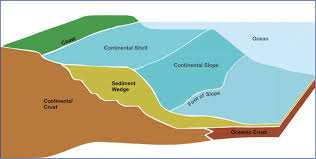 We have seen that the continental rift zones would evolve, if the process continued, towards a new ocean. With the ingression of the sea a marine sedimentation will be established on the edges of the new ocean (that is, on the edges of the two now separated continents). Climate permitting, evaporites would deposit at the base of a typical series of marine ingression. The sediments coming from the continent, from the erosion of mountain ranges, will be transported in the new sea by water streams and winds, and will be deposited on the margins of the continents. This margins will be then bordered by a strip of sediments called “sedimentary prism” (modern version of the old concept of geosyncline) which morphologically constitutes a continental platform and escarpment. This is the current situation of the edges of the Atlantic Ocean, for example. Incipient continental rift zones are in South East Africa, already evolved in proto-ocean in the Red Sea.
We have seen that the continental rift zones would evolve, if the process continued, towards a new ocean. With the ingression of the sea a marine sedimentation will be established on the edges of the new ocean (that is, on the edges of the two now separated continents). Climate permitting, evaporites would deposit at the base of a typical series of marine ingression. The sediments coming from the continent, from the erosion of mountain ranges, will be transported in the new sea by water streams and winds, and will be deposited on the margins of the continents. This margins will be then bordered by a strip of sediments called “sedimentary prism” (modern version of the old concept of geosyncline) which morphologically constitutes a continental platform and escarpment. This is the current situation of the edges of the Atlantic Ocean, for example. Incipient continental rift zones are in South East Africa, already evolved in proto-ocean in the Red Sea.
If the relative motions of the plates change direction, the convergence of two sedimentary prisms may occur. Before the convergence of the two prisms, obviously, the consumption of almost the entire oceanic lithosphere between them must be completed, through one or more subduction zones with relative island arch volcanism, as well as with the due seismicity. The first sediments to be involved in the collision are the ones called more “internal”, that is those deposited on the oceanic crust (once called eugeosyncline). The involvement consists in their “tectonization”: the most plastic ones are folded by the compression that is taking place; most of them overlap on inverse (thrust) fault planes to form the first “thrust sheets”. The direction of the superimposition (vergence) will depend on that of the subduction (which can also change during the evolution of the chain).
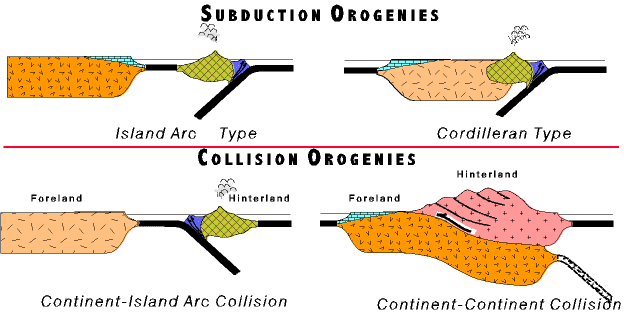 The stacking of the thrust sheets will cause them to sink deeper and deeper; the increase in pressure and temperature will allow the well bedded sediments to deform to the point of dynamic-thermal metamorphism (for example, as temperature and pressure increase, an original sandstone would transform gradually into a micaschist and then a gneiss, a high-grade metamorphic rock). In the deepest parts, the gneiss portion with the lowest melting point will melt generating acidic magmas, also called “anatectic” magmas (at about 500-600°C), which will most likely re-solidify almost totally in depth. Their high viscosity will prevent them from going up very much and will form granitic-gradioritic plutons with relative veins to support the future chain, surrounded by the contact metamorphic aureole around the incasing rocks. The whole of these phenomena, before the lifting of the mountain chain, that is the real “orogenesis”, takes the name of “tectogenesis”. The considerable thicknesses of granitoid and sedimentary material that can be obtained create an isostatic imbalance that will be compensated for by the lifting of the mountain range – the actual orogenesis, which will bring sediments once deposited below sea level to altitudes of thousands of meters.
The stacking of the thrust sheets will cause them to sink deeper and deeper; the increase in pressure and temperature will allow the well bedded sediments to deform to the point of dynamic-thermal metamorphism (for example, as temperature and pressure increase, an original sandstone would transform gradually into a micaschist and then a gneiss, a high-grade metamorphic rock). In the deepest parts, the gneiss portion with the lowest melting point will melt generating acidic magmas, also called “anatectic” magmas (at about 500-600°C), which will most likely re-solidify almost totally in depth. Their high viscosity will prevent them from going up very much and will form granitic-gradioritic plutons with relative veins to support the future chain, surrounded by the contact metamorphic aureole around the incasing rocks. The whole of these phenomena, before the lifting of the mountain chain, that is the real “orogenesis”, takes the name of “tectogenesis”. The considerable thicknesses of granitoid and sedimentary material that can be obtained create an isostatic imbalance that will be compensated for by the lifting of the mountain range – the actual orogenesis, which will bring sediments once deposited below sea level to altitudes of thousands of meters.
The highest peaks of the mountain ranges show sequences of ferromagnesiac igneous rocks, called “ophiolites”, which correlate quite well with the oceanic series cored from the ocean floors. Probably it is the superficial part of the oceanic crust “scraped” off during the subduction process; others think that it is the oceanic crust of the back-arc basin, young enough, thin and not very dense to be brought up (obducted) rather than subducted.
The type of orogenesis here described may represent in principle the Alpine-Himalayana orogenesis, in which Africa, Arabia and India moved relatively northwards closing the ancient Tethys Ocean that separated them from Eurasia.
In order to give rise to an orogenesis, even a single sedimentary prism is sufficient, i.e. it is not necessary that two continents collide. For example, in the case of the Andes, the South American western prism has been deformed by the thrust due to the Pacific lithosphere that is subducting towards it, at a rather low angle. More internally there are in fact imposing volcanic edifices due to the rising of magma generated by the subduction process.
The structure of the mountain ranges
The mountain ranges are structured into thrust systems. The most internal sediments are the first, as already mentioned, to be involved. Horizontal compression generates gently inclined fault planes along which the material overlies the relatively more external one (towards the continent). Generally the movement starts along bedding planes, lithology boundaries with different deformation behavior. From time to time the sliding cuts up the sedimentary sequence to resume sliding parallel to the stratification at a higher level. Other overlapping fronts develop further ahead; the next one will allow the thrust sheet just generated to overlap on even more external sediments, carrying “on its shoulders” the most internal overlay, and so on. The deposits that were on oceanic crust (former eugeosyncline) will then be at higher altitudes (see ophiolites), overthrusted by the continental shelf sediments, once called myogosyncline (external).
This “stacking” of embricated or “duplex” thrust sheets with a characteristic shape reminiscent of a horse (horses) thus leads to the thickening that causes the phenomena of metamorphism, anatexis and orogenic lifting already described.
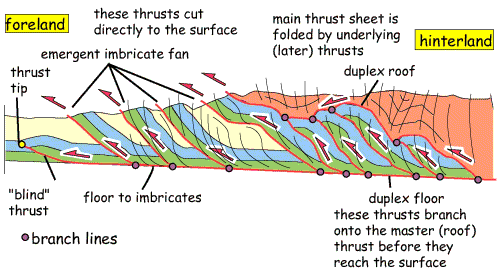 Once lifted, a mountain range is inevitably subjected to the erosive action of exogenous agents. As it is dismantled, its lightening causes its isostatic ascent. This continues as long as there are deep roots available; once finished, the area will remain flattened and the intrusive and metamorphic rocks that were at the heart of the ancient mountains will be observable on the surface. This is the situation observed today in continental shields in northern Scandinavia and Siberia, northern Canada and Brazil, among others. The sediments that made up the mountains above them are now at their edges forming the sedimentary prism of the continental platform and escarpment; the shield and platform ensemble is called a “craton”.
Once lifted, a mountain range is inevitably subjected to the erosive action of exogenous agents. As it is dismantled, its lightening causes its isostatic ascent. This continues as long as there are deep roots available; once finished, the area will remain flattened and the intrusive and metamorphic rocks that were at the heart of the ancient mountains will be observable on the surface. This is the situation observed today in continental shields in northern Scandinavia and Siberia, northern Canada and Brazil, among others. The sediments that made up the mountains above them are now at their edges forming the sedimentary prism of the continental platform and escarpment; the shield and platform ensemble is called a “craton”.
 Subduction processes are therefore a mechanism for the formation of new continental crust. Continental crust can therefore be conceived as produced starting from the oceanic crust, which is on average basaltic in composition. Basalts are the primordial rock, from which by partial fusion more acidic components are generated. Erosion processes at the surface bring them back to the margin of the continents, ready to be involved in a new orogenetic phenomenon.
Subduction processes are therefore a mechanism for the formation of new continental crust. Continental crust can therefore be conceived as produced starting from the oceanic crust, which is on average basaltic in composition. Basalts are the primordial rock, from which by partial fusion more acidic components are generated. Erosion processes at the surface bring them back to the margin of the continents, ready to be involved in a new orogenetic phenomenon.


